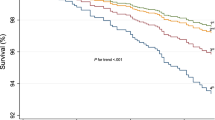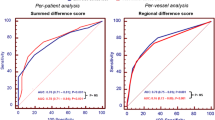Abstract.
The significance of exercise-induced ventricular arrhythmias (VAs) is largely dependent on the clinical characteristics of the studied population. The relation between exercise-induced VAs and myocardial perfusion abnormalities has not yet been evaluated in a homogeneous patient population with intermediate probability of coronary artery disease (CAD). We studied 302 patients (mean age 54±9 years, 152 men and 150 women) with intermediate pretest probability of CAD (range=0.25– 0.80, mean=0.43±0.20) by upright bicycle exercise stress test in conjunction with technetium-99m single-photon emission tomography (SPET) imaging. Exercise-induced VAs (frequent or complex premature ventricular contractions or ventricular tachycardia) occurred in 65 patients (22%). No significant difference was found between patients with and patient without VAs regarding the pretest probability of CAD (0.45±0.21 vs 0.43±0.20). Patients with exercise-induced VAs had a higher prevalence of perfusion abnormalities (52% vs 26%, P=0.002) and ischaemic electrocardiographic changes (31% vs 16%, P<0.05) compared to patients without VAs. A higher prevalence of perfusion abnormalities in patients with VAs was observed in both men (67% vs 35%, P<0.01) and women (38% vs 16%, P<0.05). However, the positive predictive value of exercise-induced VAs for the presence of myocardial perfusion abnormalities was higher in men than in women (67% vs 38%, P<0.05). The presence of abnormal myocardial perfusion was the only independent predictor of exercise-induced VAs (OR 2.2; 95% CI, 1.2–4.2) by multivariate analysis of clinical and stress test variables. It is concluded that in patients with intermediate pretest probability of CAD, exercise-induced VAs are predictive of a higher prevalence of myocardial perfusion abnormalities in both men and women. However, the positive predictive value of exercise-induced VAs for perfusion abnormalities is higher in men. Because of the underestimation of ischaemia by electrocardiographic changes, exercise-induced VAs should be interpreted as a marker of a higher probability of CAD.
Similar content being viewed by others
Author information
Authors and Affiliations
Additional information
Received 15 September and in revised form 27 October 1999
Rights and permissions
About this article
Cite this article
Elhendy, A., Sozzi, F., van Domburg, R. et al. Relation between exercise-induced ventricular arrhythmias and myocardial perfusion abnormalities in patients with intermediate pretest probability of coronary artery disease. Eur J Nucl Med 27, 327–332 (2000). https://doi.org/10.1007/s002590050041
Issue Date:
DOI: https://doi.org/10.1007/s002590050041




